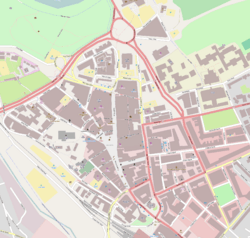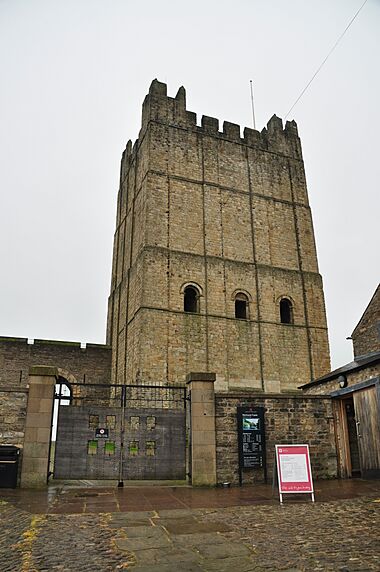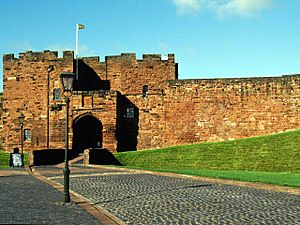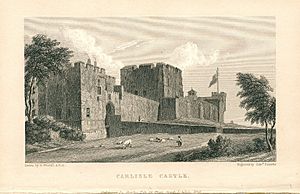Carlisle Castle facts for kids
Quick facts for kids Carlisle Castle |
|
|---|---|
| Carlisle, England | |
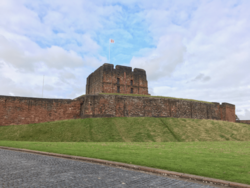
Carlisle Castle
|
|
| Coordinates | 54°53′50″N 2°56′31″W / 54.897260°N 2.941936°W |
| Grid reference | grid reference NY396562 |
| Type | Castle |
| Site information | |
| Owner | English Heritage |
| Open to the public |
Yes |
| Condition | Intact |
| Site history | |
| Materials | Stone |
| Battles/wars |
|
| Events | |
Carlisle Castle is an old stone fortress in the city of Carlisle, England. It is close to the famous Hadrian's Wall. This castle is more than 930 years old!
It was first built in 1092 by William II of England. Later, in 1122, Henry I of England had it rebuilt with strong stone. Over the centuries, Carlisle Castle has seen many important moments in British history.
The castle was very important during the wars between England and Scotland. It was involved in many battles and invasions. In 1745, during the Jacobite Rising, Carlisle Castle was the last English fortress to be attacked.
Today, English Heritage looks after the castle, and you can visit it. Until 2019, parts of the castle were still used by the British Army. There is also a museum inside the castle walls that tells the story of the local army regiments.
Contents
History of Carlisle Castle
Building the Castle: From Wood to Stone
Carlisle Castle was first built when William II of England was king. He was the son of William the Conqueror. Back then, the area around Carlisle was considered part of Scotland.
King William II ordered a wooden castle to be built in 1092. It was a "Motte and Bailey" castle, which means it had a mound (motte) with a tower and a walled courtyard (bailey). This castle was built on the site of an even older Roman fort called Luguvalium.
In 1122, Henry I of England decided to make the castle much stronger. He ordered it to be rebuilt with stone towers and thick city walls. The main tower, called the keep, was built between 1122 and 1135. This type of stone tower castle was quite rare at the time.
Battles and Changes of Hands
After the castle was built, it became a key spot in the wars between England and Scotland. The castle and the city of Carlisle changed hands many times over 700 years.
In 1138, David I of Scotland ordered the castle to be largely rebuilt after a battle. Later, in 1149, Henry II of England was knighted inside the castle. King David I of Scotland even died there in 1153.
One important event happened in 1296. A Scottish leader named John 'The Red' Comyn attacked Carlisle. But the castle's governor, Robert de Brus, successfully defended it.
In 1315, Scottish forces tried to take the castle again. They surrounded it in a siege. However, they didn't have enough supplies to keep fighting and eventually left.
From the mid-1200s until 1603, Carlisle Castle was the main base for the "Western March." This was a special area that helped protect the western border between England and Scotland.
Famous Prisoners and Sieges
Henry VIII of England made changes to the castle so it could use cannons. In 1568, Mary, Queen of Scots was held prisoner in the castle for a few months. She was kept in the Warden's Tower. People said she watched football games from her window!
Later, during the English Civil War in 1644, the castle was attacked by Parliament's army. They surrounded it for eight months.
The Last Battle and Modern Use
The last major battles for Carlisle and its castle happened during the Jacobite rising of 1745. Prince Charles Edward Stuart (also known as Bonnie Prince Charlie) and his Jacobite army took over Carlisle and the castle.
However, the British army, led by William Augustus, Duke of Cumberland, quickly drove them back north. Carlisle was taken back, and many Jacobite soldiers were captured. This battle was the last time the castle was used for fighting. After 1746, England and Scotland were united as Great Britain, so defending the border was no longer needed.
After these battles, the castle was not as important. Some parts were even taken down in the 1800s to use the stone for other buildings.
The British Army started using the castle again in the 1800s. It became a training base for different army regiments, like the Border Regiment. Even today, parts of the castle are still used by the Army Reserve.
In 1996, Carlisle Castle was officially listed as a "Scheduled Ancient Monument." This means it's a very important historical site that needs to be protected.
In 2016, experts studied the old carvings and drawings made by prisoners and others on the castle walls. They used special cameras to create 3D models of these historical marks.
Museum at the Castle
Carlisle Castle is home to Cumbria's Museum of Military Life. This museum tells the story of the local army regiments from Cumbria. You can learn about the Border Regiment and the King's Own Royal Border Regiment. It's a great place to see uniforms, medals, and learn about military history.
Arthurian Legend and Carlisle Castle
Sir Gawain's Adventure
There's an old poem from the 1300s that tells a story about Sir Gawain, one of King Arthur's famous Knights of the Round Table. The legend says that Sir Gawain stayed at Carlisle Castle. He was on a hunting trip in the mysterious Inglewood Forest.
This story is similar to another famous poem from the same time, called "Sir Gawain and the Green Knight". The tales of Sir Gawain have been made into movies many times, including films in 1973, 1984, and 2021.
Is Carlisle Castle Camelot?
Some people even believe that Carlisle Castle might be Camelot! Camelot is the legendary home of King Arthur's court. It's a fun thought to imagine King Arthur and his knights walking through the castle's ancient halls.
See also
 In Spanish: Castillo de Carlisle para niños
In Spanish: Castillo de Carlisle para niños
- Grade I listed buildings in Cumbria
- Listed buildings in Carlisle, Cumbria
- Castles in Great Britain and Ireland
- List of castles in England
- Siege of Carlisle
- High Sheriff of Cumberland


